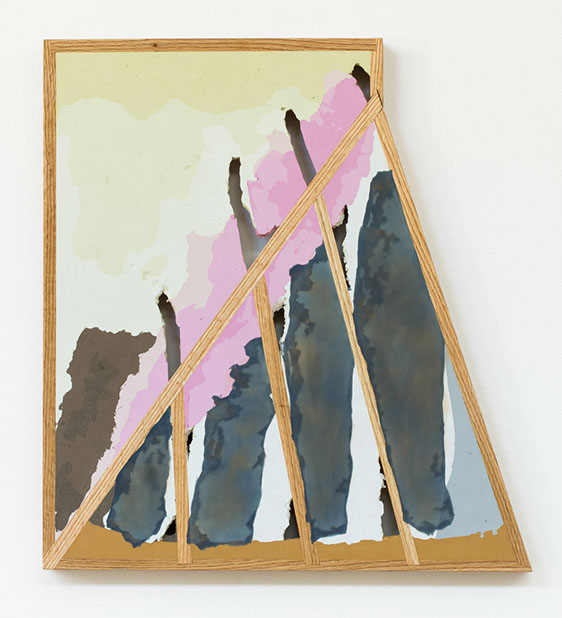
Compound Flat #38, 2014
epoxy clay, pigment, and wood
24.5 x 22.5 x 1.75 inches
Interview Pt. 2 of 2:
Scott Robinson with Christian Maychack
SR: When you left off with Will, you said you thought you would never come back to painting. Do consider yourself a painter now in some way?
CM: What happened is that I really, really believed in abstract expressionism. That was what people pushed. There wasn’t a lot of contemporary art to look at Ohio University or around there. The library was old and everyone kept pushing me toward abstract expressionism and I sort of fell in love. I believed it with every ounce. Everything they taught, that you get absorbed in this abstract space and forget about the edges of the canvas and start to commune with this thing —like Rothko Chapel kind of stuff. I was seeing it all in pictures and books. I realized when I started seeing it in person I realized it didn’t really do what they said in the books. It didn’t do what it was supposed to do. I started looking at the edges too much. And I was dating a sculptor and we had a lot of discussions about sculpture and painting. I started looking at the edges too much and stopped believing and then couldn’t enter the picture plane anymore.
SR: So the edges were really what threw you out of painting?
CM: Yes, the objectiveness of the paintings themselves. I don’t know… I became disillusioned with it.
What sort of brought me back was when I first started the compound flat series and it was sort of an accident. I was making sculptures with organic elements like tree branches, plants and things with this magic sculpt material molded around it. It was actually for Gregory Lind’s 60th birthday... he really won’t be happy I called him out for being over 60. But he came to NY to celebrate and I organized this portfolio from all of his artists that had moved to NY. I told them the size and made a wooden box and then when it came time to make my contribution, I didn’t know what the hell to do. Because I didn’t make prints, drawings or photographs or anything. I had this chair caning lying around so I was thinking about using it as reinforcement for the magic sculpt. I made a flat, magic sculpt plan and sanding it down. The way that the caning came through in spots and not others, I saw that abstract picture plane forming. I thought “this is great”. I can deal with the object and have this abstract pictorial space, this shallow abstract painting space. I don’t know if I recognized all that all at once but I know I definitely recognized something. The little scrap of thing that I gave him isn’t all that special but…
SR: It sounds pretty special.
CM: You look at it and compared to what I’ve done since it’s not that interesting. But I saw a lot and Greg knew I saw a lot in it and he was pretty excited with me.
SR: It seems good a gallery owner would be able to encourage you in a different direction. I assume they don’t always do that.
CM: I do my best work for Greg honestly. My shows for Greg, I push hard. My shows with Jeff too, but Greg is kind of a father figure so I push myself. I think in big leaps.
SR: How do you think about meaning or content?
CM: My content is about experience. It’s that space between the piece and the viewer and that experience of approach.
SR: What you see is what you see maybe?
CM: Kind of, but at the same time, what you see can be two different things. In the context of painting and sculpture —in the context of the pictorial or the presence and object— you approach them a lot of times as either of those things. There’s a lot of movement back and forth between them and I think that’s where the experience happens and that’s where the idea is. It’s in the approach. I think that word makes it into every (artist) statement. It’s about that.
SR: The form is the content.
CM: Yeah. I mean they are formal but formalism is a dirty word.
SR: Is it?
CM: I mean it’s treated like such I think —in the art world sometimes— because it often gets preceded by “just”.
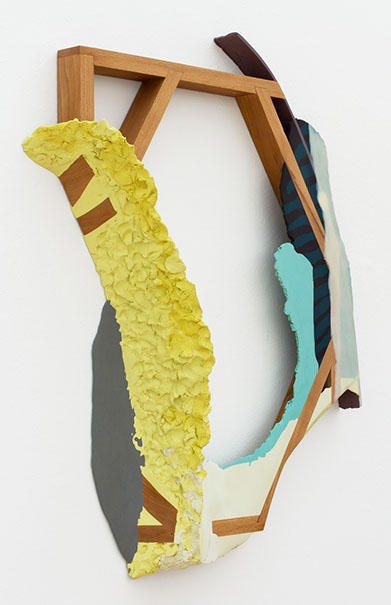
Compound Flat #41, 2014
epoxy clay, pigment, and wood
29 x 24.5 x 4 inches
SR: It’s being called decorative maybe?
CM: Yeah, or “his work is just formal” or I don’t know. It’s probably a lot in my head too. But I do feel that in the art world sometimes when, you know, those binaries of conceptual and formal… it’s sort of silly and old but it sticks around I think.
SR: Are those binaries important to you? Do you think about multiple binaries?
CM: Yeah they are important but they are not... I definitely think about structural vs. organic. That’s been a binary since I started making work. I think in that first interview, I talked about obsessively making grids. That was in the very beginning. I wanted to make sense of this thing so I was making grids of organic cell-like shapes and they were abstract. They really didn’t have meaning as cells, but that was a way in for me. Honestly, I was sort of grappling with that and now there is still a vestige of that rigid and organic. It’s been in every bit of my work that I’ve done since the beginning.
SR: Does that relates to how, you’ve mentioned in the past, you’re concerned with the way viewers feel their sense of presence in relationship to your work.
CM: Or how I hope they will feel.
SR: Right. When you’re thinking of anatomy or cross sections —which these look a lot like— there’s an obvious relationship to the body. Do you think that’s part of it?
CM: It might be part of it. I think what I’m thinking of is going back to the approach. That oscillation between getting lost in the pictorial space —abstract and visual space— and having this reminder that wood coming through is an object; that this color, this material is an object. Nothing is on top of anything else. There’s no hierarchy to structure, to color and structure, and pictorial space.
SR: When you make these cross sections they’re almost like photograms. Because they are so outrageously flat, the illusion is that there is an illusion, that it’s not the material that it is. It’s this flatness that totally blocks you out of entry into pictorial space.
CM: Right. I think that some of them do both.
SR: They’re starting to.
CM: Yes, that’s true. They are a little more painterly —some of the newer ones— and they’re a little more object too, going towards stretching apart and sort of turning themselves inside out in a way. That’s one thing I’ve been wanting to do more and I think I have started to in my last show with Gregory Lind. I like the flatness of them but it could become a crutch and a little too easy. I want to sort of push in both directions. I hate to use the words “super flat” because that was such a big exhibition that has nothing to do with what I’m doing but…
SR: It is literally super flat.
CM: I just want to pull them apart and make more have to happen to the viewer.
SR: In terms of how they approach the work in a 3-dimensional sense?
CM: Yes, but also in more pictorial passages. It’s more painterly.
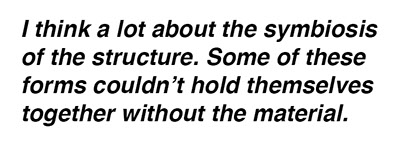
SR: And it’s not surface necessarily, because it is literally part of the object. They have to walk around it.
CM: Yeah, I think a lot about the symbiosis of the structure. Some of these forms couldn’t
hold themselves together without the material. It’s where that sort of color, image becomes structure for what would be traditionally the structure.
They support one another in a way, going back to that “no hierarchy” of image and object.
SR: Size or scale has a lot to do with the way a viewer relates to the piece. How do you think about size? Does it just happen?
CM: I think it just happens. It would be silly of me not to acknowledge that there are constraints. There are constraints of time. For me it’s not like I can just stretch a really large canvas and go crazy on it —not to diminish someone who stretches a large canvases, I know it’s a lot of work— but for me it’s exponentially more work because it’s so physical. It’s so much mixing of color. Mixing the color into this Magic Sculpt it takes a lot of time.
If I want to work through ideas, my ideal is that I have six to eight going at the same time. To work through ideas fast enough, these things take a while. To work on really large pieces… I want to. I really want to, but for that I need some assistants. I do find something I like about this size, around 24”. Actually they have been getting larger 40” to 40” plus.
As they would get much larger, the relationship to the picture plane would change a lot. There’s something about the scale and the mental entry into them.
SR: It’s more intimate.
CM: Yes, it’s more intimate and going much larger, I would have to rethink how I would relate to the viewer’s body. I have done that with the freestanding sculptures I think. They’re about (human) body size.
SR: It sounds like you’re also concerned with taking the mark out of the field —instead of encompassing the viewer— as something they can relate to, in a way.
CM: Yeah. That’s a good point.
SR: With the abstract expressionists, you walk to it and you’re in infinite space with a Pollock, or you’re floating with Rothko.
CM: Motherwell would probably be a very good example of where, those shapes in his elegy series… those shapes. That body size would be nice. But I don’t want to do Motherwell. That could be an interesting solution. Maybe.
I am feeling like tackling a larger project, but it would have to be ongoing with lots of little ones just so I could work through stuff faster. Otherwise I’d get bored.
SR: So if you would, walk us through your process briefly. It seems like that’s really key; how they’re made.
CM: It varies a little bit, but most of them start off with a lot of sketching of wood structures and how could I build those.
SR: Does it take a lot of planning? I know very little about wood shaping but does it take a lot of time? I mean sketching a shape, bending it and shaping it. How do you even bend it in the first place?
CM: That’s just geeky stuff, the bending of wood. That was a lot of time spent on the internet looking at woodworking websites. That shit I love. I can get lost in it for too long.
SR: You’re basically an expert.
CM: Well, I don’t know about that. Because, if you look at woodworking sites, I’m definitely not. But for what I need… there’s a lot of slop allowed in what I do.
I would come up with structures on paper for wood things. I’m not too concerned about mistakes. There’s something equalizing about the sanding process and putting this color of magic sculpt around it. Because I want it to act like marks, like structure and marks, I want it to have character. I don’t want it to be these perfectly built structures like I’m making furniture. Although I think, to a lot of people, they look “perfect”.
Surprisingly there is a lot of slop in this work. I wouldn’t do it if there weren’t.
SR: So chance is very important.
CM: Super important. A lot of the sketching I do for the wooden structure… the structure will often look similar. But then what I do with it afterwards… I’ll make the structure, I’ll photograph it, I’ll do lots of sketches. Sometimes I’ll jump in and start putting color down. Some I work backwards, some I work from the front. The backwards ones they feel a lot like making prints or like…
SR: Photograms?
CM: I haven’t done many photograms, but I like that reference because I haven’t thought about photograms before. But like paper making, pulp painting, working backwards feels a little like that but working from the front feels more like painting but with a lot of trust, because I don’t know what they’re going to sand like. They look ugly as hell but I have to trust that I know what I’m doing.
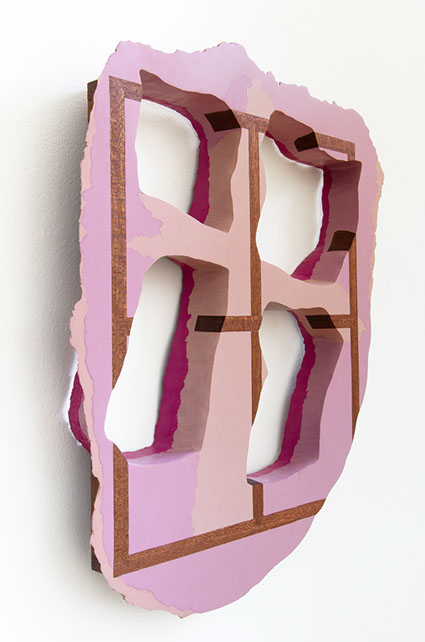
Fours (CF37), 2014
epoxy clay, pigment, and wood
26 x 22 x 3 inches
SR: But you’ve started, it looks like, leaving more of that three dimensional quality —that you’re calling ugly, I’m calling it a mark.
CM: Yes. I feel like a lot of my process, the trial and error part is about me doing something and feeling really uncomfortable with it, but forcing myself to keep it for a while, to make myself sit with it. Sit with the discomfort. Sometimes I come around to it and think “okay I can keep that, that can be interesting”. It’s not terrible. It’s not a ruinous mess.
SR: I know you love Diebenkorn and I’m trying to remember his quote. He said something like, you’ve got to learn how to tolerate chaos. I need to pull that out and get it correct. That’s from years ago.
CM: Yeah, I do love Diebenkorn… I did more, but I’m coming around to him again.
SR: It’s easy to.
CM: Yes. It is. Well, I don’t know, I think people find him really boring.
I liked that you could see all his layers. But they were so tight and tidy though. Whatever, mine is too, but I liked that you could see all of his mistakes. Or not mistakes but things that he would put a layer over and let it be. My work doesn’t quite work that way.
SR: Well you’re bringing that into the sculpture. It’s totally different but it’s interesting that there is overlap.
CM: Yeah. That and I think now that I’m working with translucent layers, that’s starting to come forward more. I’m trying to let it be. But sitting with discomfort, I know that’s a huge idea of meditation and yoga and whatnot. I don’t know if that’s where it comes from, but I don’t do much of that stuff. It’s a great idea. Because I am quick to judge something I’ve done and to want to immediately undo it. So it’s taken me a long time to be okay, “this might have value”. I have to move on to a different piece before I fuck this up or just make it boring.
SR: Something you don’t do that with —that I learned in the studio visit we had— is the support structures you build that act as molds for your pieces. Will, during the visit, asked why you don’t use those as sketches. Because they can be very attractive.
CM: Yeah, I am seduced often by the backs of the structures, the backs of the pieces. Often people will be like “whoa, the back is really cool” when I show it to them. Yeah, it’s cool, but I feel like there’s something…
This one time when I was making more of a freestanding sculpture, I made a structure to ship a sculpture that ended up looking really fucking cool. That happens a lot, I did art handling and you make these weird shapes to hold a piece. You think, “wow, that’s pretty sweet. That structure is kind of awesome.” People will say, “well why don’t you do that?” The reason I don’t is I feel like you… Say that I decided to make that structure as part of my work. The molds that I make to build that thing —because they’re unintentional— become the most interesting part than the thing I’m chasing. So I feel it would just keep going, that you’d keep falling in love with the thing you used to make the thing.
I photograph them and try to let them be in my head when I’m working so that maybe the best parts will work my way into my subconscious. And I think that is why my work is turning itself inside out and I’m stretching these things apart and it becomes less flat. But the parts that are flat are more painterly and ones that aren’t are more sculptural. I feel that’s the result of not chasing the thing. I feel like I’d just chase myself in circles.
SR: This may be an unanswerable question, but what means that you’ve made a successful piece? I’m thinking about authenticity and intention in regards to how you approach your castoff structures. How do you judge a work’s success in relation to others?
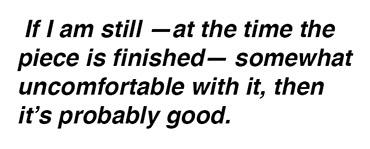
CM: I don’t think I can. I don’t think it’s possible. I get caught up in this thing when I’m working on a new show. Or when I’ve had one body of work end, and had a space of time and then a new body of work. I keep wanting to go back and feel more comfortable, and am not sure where this next show is going to go. I go back and look at the (older) work and think “I like that piece”. How did I make that piece? How did I get there? Forgetting that I felt exactly the same way when working on that (older) piece not knowing if it was going to be successful. Or going back and forth from thinking “Whoah, this piece is sweet” to “I don’t fucking know, this could be awful”.
Sometimes those are the best. When I’m going back and forth from being like “this is amazing” and “this is awful” and not knowing the difference. I think that’s where “sitting with discomfort” comes in. If I am still —at the time the piece is finished— somewhat uncomfortable with it, then it’s probably good; hard, but good. When I’m finished keeps changing. And I try to keep it changing because I’m trying to bring them to different levels of finish now; like sculptural and more painterly. When it still has something to give, something for the viewer to do some work, maybe. I’m not sure.
SR: I feel like because of everything you’re talking about, you’re able to struggle and find a way forward with your material restrictions. I wonder if you feel that those restrictions are freeing in a way.
CM: Yeah.
SR: I should specify epoxy and wood.
CM: If I were to just start putting down epoxy, it’s like there would be no structure or grid. I almost treat the wooden structure that I draw out, and all of my woodworking, as sort of getting to the point of a found object. Then I can deal with that. I can make this structure and accept the structure as something that exists, and then work with the structure.
I think that’s why I work that way. It gives me something to work against, to fight. I think that’s why the pieces that have been sitting on my wall the longest and have given me the hardest time are the ones that are shaped, and don’t have any sort of a relationship to a rectangle. I’m going to deal with them. They’re much harder for me.
SR: Is that one of them with the curve and blue and the green on the wall?
CM: Yeah. That one. That one’s been sitting there for a long time. Well I did it last October… or no, in December in Vermont Studio Center. I’ve just been sitting with it and I’ve got all this bent wood on the floor with also the same issue. But I’m going to fight. I’m not going to turn that into a rectangle.
SR: Well, you mentioned Vermont Studio Center. You went there because of a really unfortunate mess/event.
CM: Yes, hurricane Sandy. In a way that was terrible, I lost like ten pieces.
SR: It was right after your show, wasn’t it?
CM: Yes. It was a show with Jeff Bailey. The show came down and it went into the

Unfinished work in studio
Photo: Scott Robinson
basement storage and two weeks later hurricane Sandy hit so I lost a lot of work from that show. And then some other pieces, which I was not so sad to lose because they were old and I didn’t like them. I preferred that Jeff stored them than me. For the most part, I lost work that I thought I needed more time with.
But a lot of good came from that for me: the Vermont Studio Center residency, a NYFA grant, and the residency in France. By the time I got to those residencies, it was already a year later. I thought I didn’t need them anymore by the time I got to them. But it turned out I really did. I needed that time to shed that old work and figure out where I was going to go next. It was hard to do that knowing that that work was gone. I kind of felt like I needed to recreate it, but didn’t want to. That kernel wouldn’t go away.
SR: Was it really difficult to get started again after all the work that had been destroyed?
CM: Yeah. It was really difficult. I think I wanted to recreate some of them but knew I wasn’t going to. There was one piece from my last show that, it was the only piece that I decided I was going to recreate the beginning of that piece. It was the only log piece from that last show with Gregory Lind.
There was one from my show with Jeff that was very much a reference on Gottleib. I really wanted that piece back. I knew I could straight up recreate it but that was going to be boring and it would probably be sad. So I decided to head in that direction knowing full well that it would go somewhere different. I felt that that was a good thing to do but I didn’t feel like I needed to do it again, I just needed to push it to a new realm.
SR: Have you done that with other works where you respond to one that you feel like had a direction in a similar way? Revisit a starting point?
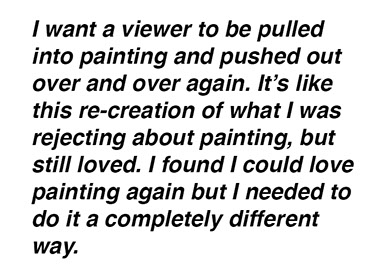
CM: Yeah, I think so. Maybe I do that every time I create a rectangle out of wood. And then I want to figure out how to push as far away as I can from everything I’ve done before. That rectangle is really kind of important.
SR: But you’re trying to get rid of it.
CM: I want to use it less. I keep being drawn to it. Maybe it’s that anchor of painting and what drew me back into painting to begin with and what will kind of push me out of it. Maybe this process is just- I want a viewer to be pulled into painting and pushed out over and over again. It’s like this re-creation of what I was rejecting about painting but still loved. I found I could love painting again but I needed to do it a completely different way. And I feel that maybe that process of what I hope people do, in looking, maybe sort of recreates that. I’m questioning in a sense.
SR: That struggle.
CM: Yeah, that struggle.
SR: How important was the move to New York? Every city is unlike every other city but New York is such a concentrated mass of artists. How important is community for you?
CM: It’s really hard to tease it out I suppose. It’s hard to say how it comes in but I know, I left San Francisco in 2008 after going to Skowhegan. The Skowhegan experience, that kind of community was incredible. I had already planned on moving to New York before that but that cemented it for me. Over the years, a lot of people left San Francisco. I think the community was getting thin. There is a strong sense of community in San Francisco, but I didn’t feel pushed by it anymore. It’s very accepting, which is good but I just needed a little pushing. I needed some more drive. A lot of artists in New York had so much more drive than what I was witnessing in San Francisco at the time. I had already kind of done a lot there. There were a lot of places I hadn’t shown yet, but we didn’t match. I needed to find a community that would push me more and give me more opportunity.
Yeah, it’s really important. Like studio visits. They’re so important. I don’t do them enough and I should do them more, especially visiting other artists’ studios. I get so much out of those conversations that I take back. Not as much from shows and openings. Sometimes that feels like the same conversations over and over again. It’s amazing how little you talk about art when you’re at art openings.
SR: Or look at it...
CM: I try. I try really hard to, if I’m feeling awkward, just to walk around the room and actually look at stuff until I stop feeling awkward and run into a friend, so that helps.
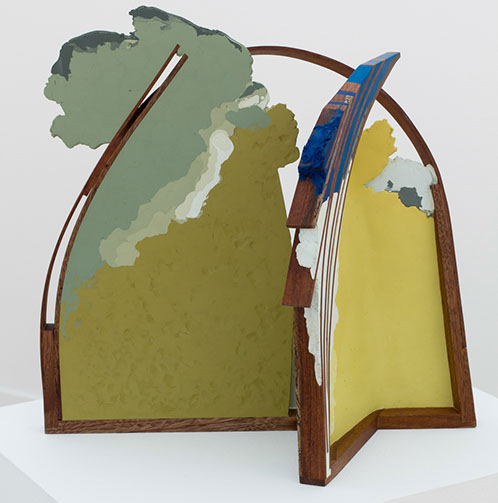
Set Up (CF40), 2014
epoxy clay, pigment, and wood
18 x 18 x 12 inches
SR: Is there someone specific that’s been really important to you in your development, maybe? In New York, or really at any point. You’ve already mentioned Gregory Lind.
CM: With Greg it’s a very special like, he’s like a father figure, he’s like my biggest supporter and he’s one of my best friends, and he’s also my dealer in San Francisco. That’s the best thing I could hope for in that context.
I think the friends I’ve made at residencies honestly, a lot of them happen to live in New York. I think the time at a residency, you’re so open to new experiences and so open to ideas, and just open in general that you make really fast and strong friendships. A greater percentage of them lived in New York or moved to New York after the residencies, so I have a tight community of people like that here. That’s probably the most influential. Also, there are a lot of people that lived in SF that I’ve kept a relationship with here. We’ve all left for similar reasons and all push each other.
Going back to Skowhegan, somebody who is really important to me is Francis Cape. He was faculty when I was there. I had a body of work coming from San Francisco because I lived there at the time that I went to Skowhegan, that I was doing well with locally and I’d already showed with Jeff Bailey in New York. I was pretty committed to that body of work even though it had outlived its usefulness to me and I was having a hard time changing. I knew I needed to, but I was getting all this support.
SR: That’s a tough thing and I feel like that happens to a lot of people who any have success. It makes you think “I should repeat it since this is what everyone values” and “I shouldn’t change”.
CM: Yes, and I felt like the work was changing, but the center of the work in general needed a change. I was changing it from the outside, but some of the ideas I was working from were flawed.
SR: Would anyone have known that besides yourself?
CM: When I got to Skowhegan, Francis came. The third day I was there I had a studio visit with him. He saw right through it. He enumerated all of the things that I sort of knew in the back of my mind were there and were problems, but I was sort of pushing ahead anyway. It totally rocked my world, tore me down. The next five weeks were hell for me. I tried to rethink what I was doing and I came to a breakthrough that wouldn’t really come to fruition for another year. But it completely changed my work. To the point where in my file keeping system on my computer, everything that came before that is called pre-Skowhegan and then everything afterward is called artwork. I forget exactly what it’s called but everything before is pre-Skowhegan. He really pushed me into that new realm.
SR: You could rename it pre-Francis Cape (laugh) to be more specific.
CM: Yeah, I could. I should.
SR: Although I’m sure other people were helpful. It seems like a turning point.
CM: It was such a drastic change for me. It sort of just flipped my work around. I visited him and his wife this past weekend upstate. He’s been important to me ever since. He’s been a huge influence. Even though our work… we have similarities in the way we think about, well I don’t know. We’re both woodworkers and love woodworking and he’s an amazing conceptual artist. I feel like I’m rambling now.
SR: Do you both like Nick Offerman a lot? I’m kidding.
CM: Wait, I do love Nick Offerman.
Christian Maychack is represented by Jeff Bailey Gallery in New York City and by Gregory Lind Gallery in San Francisco
He lives and works in Brooklyn
Scott Robinson is the founding editor of Painting Is Dead.
Studio of Christian Maychack
Photo: Scott Robinson
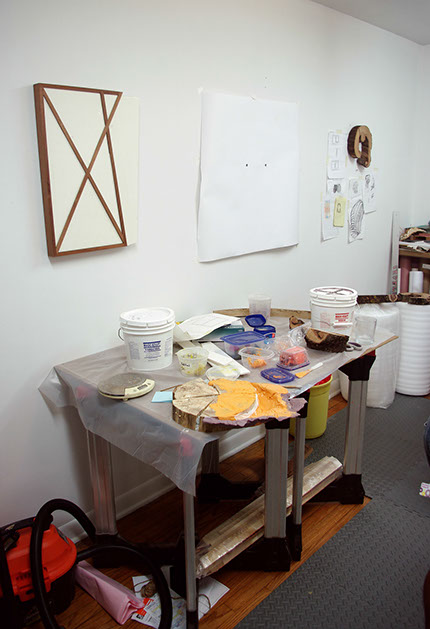
Disclaimer: All views and opinions expressed are those of the authors and do not necessarily reflect the views of the editors, owner, advertisers, other writers or anyone else associated with PAINTING IS DEAD.
